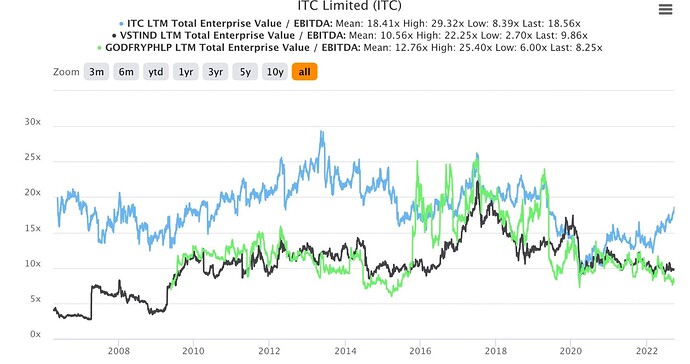I have made the following changes to the model portfolio:
- Reduced position size in Cochin Shipyard from 4% to 2%
- Reduced position size in ITC from 8% to 4%
- Created 2% position in Godfrey Phillips
- Created 4% position in Chamanlal Setia
So cash continues to be zero in the portfolio.
Drop in position size in Cochin Shipyard is due to rerating in the co from 7x PE a few months back to 14x now. When I had initially written about the company last year, I had asked the question “Will it ever become a growth stock”? If it reaches 20x earnings, I will say yes and sell.
Over the last 5-6 years, I have seen that the easiest way to make money is to buy good dividend paying cos at 5%+ yield (sustainable and not due to one-time things) and simply hold it until market gets excited about it. In this category, I have made gains in cos like Powergrid, ITC, SJVN, Cochin Shipyard. Another company which fits this criterion is PFC, but somehow I could never pull the trigger as its a leveraged play. Currently, I am looking to add Petronet LNG in this category of stocks.
ITC has tested patience over a period of time, but it has been very rewarding. In terms of rupee value, I have made the maximum gains here and the IRRs have now reached 26%, which is why I have started reducing the position as there are better opportunities available (such as Godfrey Phillips).
I have already written about Godfrey Phillips in the previous post, so I will not repeat the thesis. The basic idea is fast growth and reasonable valuations.
Chamanlal Setia is a basmati trader and has better return metrics vs market lead KRBL, and has also grown at higher rates, despite being in a sector often plagued by debt issues. Every 4-5 years, Chamanlal seeds a new market or a new set of customers, which results in 50%+ sales growth (FY14, FY18). In the next couple of years, they work on improving margins.
FY23 is another year which will show 50%+ sales growth. I expect margins to revive in the next couple of years, leading to a large delta in earnings. Its attractively valued even on trailing earnings where margins have been subdued (7.5x earnings, 3.5x EV/EBIT). So, I expect good growth in earnings in next few years, and hopefully some rerating.
Updated portfolio is below.
Core compounder (42%)
| Companies |
Weightage |
| I T C Ltd. |
4.00% |
| Housing Development Finance Corporation Ltd. |
4.00% |
| NESCO Ltd. |
4.00% |
| Eris Lifesciences Ltd. |
4.00% |
| Ajanta Pharmaceuticals Ltd. |
4.00% |
| HDFC Asset Management Company Ltd |
4.00% |
| Aegis Logistics Ltd. |
4.00% |
| Gufic Biosciences |
4.00% |
| HDFC Bank Ltd. |
2.00% |
| PI Industries Ltd. |
2.00% |
| Shri Jagdamba Poly |
2.00% |
| LINCOLN PHARMACEUTICALS LTD. |
2.00% |
| Godfrey Phillips |
2.00% |
Cyclical (46%)
| Companies |
Weightage |
| Kolte-Patil Developers Ltd. |
4.00% |
| Sharda Cropchem Ltd. |
4.00% |
| Avanti Feeds Ltd. |
4.00% |
| Aditya Birla Sun Life AMC Ltd |
4.00% |
| Alembic Pharmaceuticals Ltd. |
4.00% |
| Amara Raja Batteries Ltd. |
4.00% |
| Chaman Lal Setia Exp |
4.00% |
| Ashiana Housing Ltd. |
2.00% |
| Ashok Leyland Ltd. |
2.00% |
| Heranba Industries |
2.00% |
| Kaveri Seed Company Ltd. |
2.00% |
| Control Print Limited |
2.00% |
| Sundaram Finance Ltd. |
2.00% |
| Time Technoplast Ltd. |
2.00% |
| RACL Geartech Ltd |
2.00% |
| Manappuram Finance Ltd. |
2.00% |
Slow grower (2%)
| Companies |
Weightage |
| Cochin Shipyard Ltd. |
2.00% |
Turnaround (4%)
| Companies |
Weightage |
| Punjab Chem. & Corp |
4.00% |
Deep value (6%)
| Companies |
Weightage |
| ATUL AUTO LTD. |
1.00% |
| Jagran Prakashan Ltd. |
1.00% |
| D.B.Corp Ltd. |
1.00% |
| Shemaroo Entertainment Ltd. |
1.00% |
| Modison Metals |
1.00% |
| Suyog Telematics |
1.00% |
![]()






